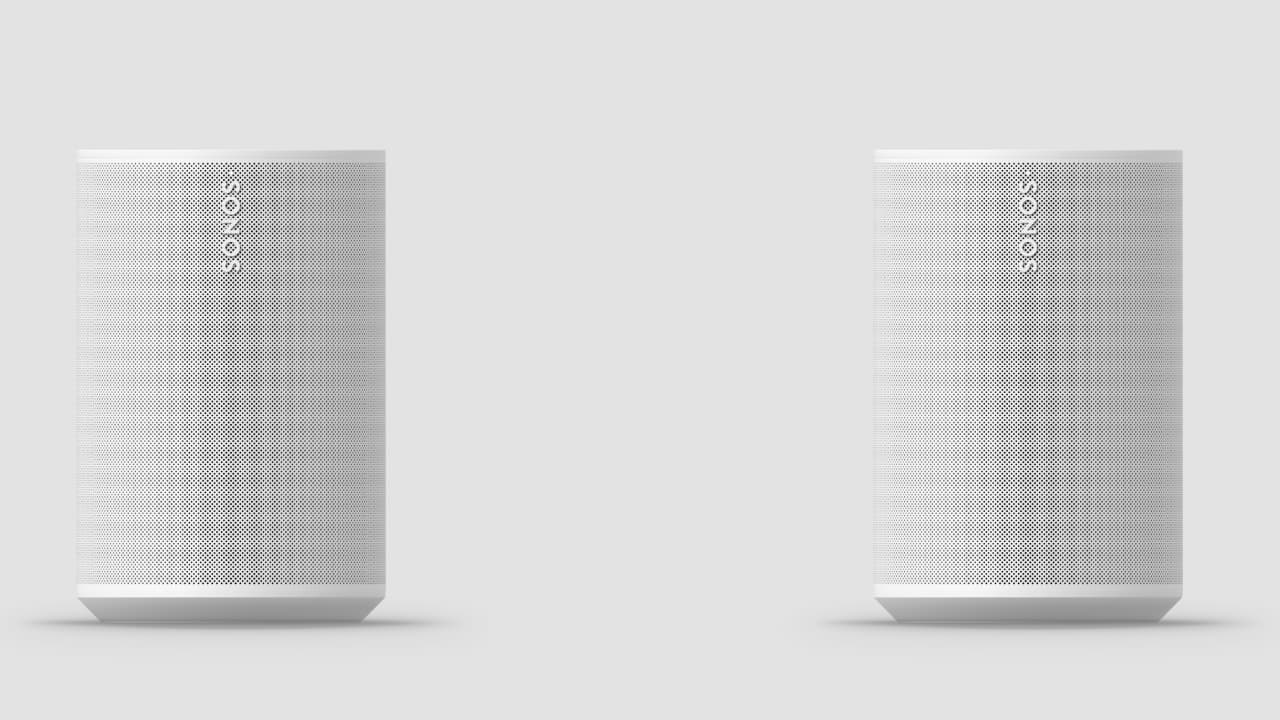
The Sonos Era 100 is $200 cheaper than the Sonos Era 300, so how do these compact wireless speakers compare in sound quality when used as a stereo pair? Surprisingly well.
The Era 100 is a compact cylindrical Bluetooth speaker that is also firmly part of Sonos’ wireless, multi-room ecosystem. It’s the smaller sibling to the Dolby Atmos-capable Era 300 and the price reflects that: $249 against $449. In some ways, the two loudspeaker designs couldn’t be more different, but in others, they couldn’t be more similar, sharing a common design philosophy and similar user controls. Note that I’m not interested in home theatre sound. My interest is in music, and that’s what I’ve tested these speakers for.
I’ve used Era 300s for about a year now, arranged in a stereo pair. TL; DR - I love them. They sound better than many expensive HiFi separates set-ups, and yet they do much more. You can read my two reviews here: Sonos Era 300 reviewed: “the best wireless speaker I have heard.” (single speaker) and The Sonos ERA 300 speaker: now in stereo (stereo pair).
Recently, I obtained two Era 100s. I wanted to compare them in a stereo pair with the Era 300s, and I was intrigued to hear how different they would be. And they should be different, because the Era 300 costs nearly twice as much as the Era 100. The Era 100s are notionally each capable of stereo reproduction but I’ve never noticed much effect from individual speakers.
A question of balance
In a configuration that I wouldn’t recommend, I balanced the two Era 100s on top of my Era 300s, on top of two very substantial speaker stands, so I could do an instant comparison between the two speaker types. In addition, I had a Sub Gen 3 to augment the bottom end of the Era 100s. Not only was this arrangement physically somewhat precarious, but it potentially masked some of the sound from the Era 300s, which include upward-facing speakers. But I tried the spatial audio speakers with and without the physical presence of the Era 100s, and I couldn’t hear a difference.
I set up each speaker type as being in a different “room”, so, from the Sonos App, I could play them one after another or - just out of interest - all together. I left the subwoofer out of most of my listening tests because, honestly, it was overkill: I suspect the smaller Sub Mini would have been better. But the results with the Sub were interesting, nevertheless.
And indeed, there was a significant difference between the two Era types, but it wasn’t what you’d necessarily expect. So, what did I expect?
Different stereo feel

I anticipated that the Era 100s would sound smaller (because they are smaller) and that they would not sound as capable overall. But that wasn’t my main impression. I found that the difference was in the feel of the stereo image. The Era 300s ace it here. Each loudspeaker unit has six amplifiers and six speaker drivers. A stereo pair has twelve. That’s a lot of resources, and it all adds up to an image that doesn’t seem to come from two point sources, but, instead, forms an incredibly stable “cloud” around the speaker pair. Virtually all content types sounded good to me - from string quartets to full orchestral works and from Shy FX to vintage Stevie Wonder. The Era 300s manage to achieve an almost holographic but incredibly stable sound stage that isn’t just limited to a single “sweet spot”. You can move around the room quite a bit, and still get the same effect, within reason. Of course, some of this is subjective, and others might have different experiences, but I did ask others to listen, and they mostly agreed with my conclusions.
Switching to the Era 100s kind-of “collapsed” this detailed stereo image into something much more conventional and familiar. But it was still very good. The Era 100s don’t have the same degree of bass extension as the Era 300s, but they can still blast out a song without distortion and with quite acceptable bass. Some may even prefer the more utilitarian stereo image of the Era 100s, and I would certainly find it more than acceptable.
With both types of speaker, I had to turn up the higher frequencies on the “EQ” slider in the Sonos App. Both defaulted to a sound that was somewhat lacking in sparkle, but the treble boost made them sound significantly better.
App’y daze
Speaking of the Sonos App, you may have heard that it has been a source of pain for the company and - unfortunately - its users. I do have some sympathy for Sonos, which has had to re-invent itself several times over the last decade or so to stay relevant and current with the latest technology, but the upgrade was over ambitious and underdeveloped. The downside is that users with older equipment - especially those with a large local store of “ripped” CDs- have struggled to get their original setup to work with the new app.
I have to say that I have had precisely zero problems with the app, and that may be because I have only used it with the latest generation of equipment. This doesn’t help any users with legacy setups, but it should encourage new potential users who might be currently on the fence about buying into the Sonos ecosystem. Currently, I can’t see any reason not to, and there are some decent deals out there right now.
Bringing out the bass

Finally, I tried out both types of speakers with the Sonos Sub Gen 3. This is a beast of a subwoofer, and you both hear it and feel it. To use it with the Era 100s, you have to “tame” it by reducing its volume to a level where you don’t hear the sub as a distinct speaker. If you get this right, the Era 100s and the sub integrate well, but I have to say, never as well as the lower end melds with the higher end on the Era 300s.
If this paints a confusing picture for you, it is, slightly. The bottom line is that if you can afford it, buy the Era 300s. Their fully integrated sound and the quite exquisite stereo image is beautiful to behold. But what if I couldn’t have the Era 300s? Would I buy two Era 100s? Absolutely. I fully accept that there are differences, but you still have the full range of multi-room features, and they sound very good indeed in a way that totally belies their size.
Would I buy a Sub Gen 3 to use with them? Probably not. It’s a fantastic unit, but I suspect it’s better for home theatre systems, where it will sound spectacular and probably shake your house off its foundations without breaking into a sweat. Essentially, it’s quite simple: two Era 100s are good value, extremely capable small wireless speakers. If you want more bass, don’t buy a subwoofer; instead, buy two Era 300s.
tl;dr
- The Sonos Era 100 is priced at $249, while the Era 300 is $449, highlighting a significant price difference with varying capabilities in sound quality.
- In testing, the Era 100s produced a more conventional stereo image, while the Era 300s created a stable and expansive sound stage, described as holographic with excellent spatial quality.
- Both speaker types benefited from a treble boost using the Sonos App EQ slider, as they initially lacked higher frequency clarity.
- Though the Sonos App has faced criticism, it can be reliable and issue-free with the latest generation of equipment, making it a good choice for new users considering the system.


Comments